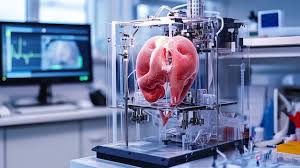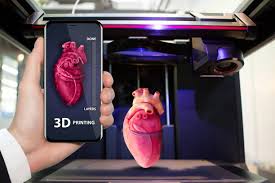
3-D PRINT HUMAN ORGANS
INTRODUCTION
3D-printed organs are constructed out of stem cells taken from the patient.
Through a process known as cell differentiation, these cells are instructed to carry out very specific tasks in the body, which enables researchers to deliver organ-specific and patient-specific treatments faster and at scale.

HOW THE 3-D ORGANS PRINTED?
Step 1: Developing the 3D Model
To 3D print anything specific, you need a model. A generic model might be fine, but with imaging techniques (such as MRI and CTI scans) and advanced software, a specific 3D model that would fit the patient can be created.
By personalizing the 3D model and, ultimately, the finished printed organ, the chance for a successful implant increases.
Step 2: Harvesting the patient’s cells and selecting the biomaterial
To further minimize the risk of organ rejection, using a patient’s own cells is beneficial. These cells are then grown and mixed with a bioink which has been specifically made to print the desired tissue.
To put it in other terms: In an ordinary printer, if you are looking to print black you need a black ink (or an imitation thereof). Similarly, if you are looking to 3D print a heart, you need a heart ink.
Step 3: Printing the organ model
After the 3D model has been finalized and the cells have been cultured and mixed, it is time to print the organ. The bioink, containing the patient’s cells, is printed following the 3D model design. It is also possible to add cells after the 3D construct has been printed.
The exact printing techniques and bioLinks that will be used are what researchers around the world are working on.
TYPES OF ORGANS PRINTERS:
The types of printers used for organ printing include:
- Inkjet printer
- Multi-nozzle
- Hybrid printer
- Electrospinning
- Drop-on-demand
APPLICATION OF 3-D PRINTING ORGAN MODEL:

ADVANTAGES:
Personalized Medicine: 3D-printed organs can be custom-made to match the exact biological structure of a patient, reducing the risk of rejection when transplanted. This could revolutionize organ transplants, providing more effective and tailored solutions for individuals in need.
Overcoming Organ Shortages: The ability to 3D-print organs could significantly reduce the shortage of available donor organs. This would help save many lives, as patients wouldn’t have to wait for a suitable donor to become available, especially for organs like kidneys, livers, or hearts.
DISADVANTAGES:
Technical and Biological Challenges: Printing complex organs that function properly is still a major hurdle. While simple tissues can be printed, creating fully functional, intricate organs with blood vessels, nerves, and the right cellular structure is extremely difficult. Ensuring the organs work like natural ones, including the integration with the body’s systems, is still a work in progress.
Ethical and Regulatory Issues: The development and use of 3D-printed organs raise numerous ethical concerns, such as the potential for human enhancement or manipulation, and the risk of “designer” organs. Additionally, there would need to be strict regulatory oversight to ensure safety, efficacy, and fairness in the distribution of such organs, which could be complicated and time-consuming.

